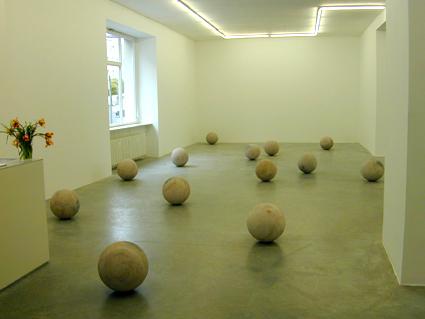Not Vital
dal 26/4/2004 al 5/6/2004
Segnalato da
26/4/2004
Not Vital
Galerie Nordenhake, Berlin
For this exhibition Vital has brought together three new works under the Rhaeto-Romanic title 'Milla larmas id un chamel' ('a thousand tears and one camel'). With 1000 Tears, 2003, the visitor finds himself faced with a rectangular block out of Carrara marble. At one side of the stone, a thousand tears have marked it as if raindrops falling on water, on the other side, the stone apparently is left in its original state.

Milla larmas id ün chamel
Galerie Nordenhake has the pleasure to present the Swiss artist Not
Vital in his first solo exhibition with us in Berlin. Vital's art is to
a large extent characterised by a presence of opposites. Well known is
his juxtaposition of materials, such as gold, marble, and glass, with
their firm roots in art history, with unexpected items of organic
provenience, such as dung or dried carcasses of animals. Other
polarities informing his imagery are his distinctive mix of figurative
elements with abstractions, or how the general ambiance of his works
seems to be destabilised by an unsure line of demarcation between utmost
sincerity and outright humour.
One point of access to Vital's art is however his strong relation to the
place—the topos. His works are "topological" in the sense that the
locality where they have been made always seems to govern his choice of
medium, content and execution—and since his field of operation stretches
over a large part of the globe, including New York, Italy, Niger, and
his native canton of Graubünden, his art takes on a distinctly nomadic
character.
For this exhibition Vital has brought together three new works under the
Rhaeto-Romanic title "Milla larmas id ün chamel" ("a thousand tears and
one camel"). With 1000 Tears, 2003, the visitor finds himself faced with
a rectangular block out of Carrara marble. At one side of the stone, a
thousand tears have marked it as if raindrops falling on water, on the
other side, the stone apparently is left in its original state. The
exquisite finish of the white stone gives the piece an ephemeral quality
- as if the material was consisting of melting ice or brittle chalk.
Vital is widely known for works incorporating the remnants of animals.
His Camel, 2003, is laid out as an installation of 15 balls of
terracotta encapsulating the dismembered pieces of an entire dead camel.
Vital's fascination in camels started after a trip to Egypt in 1998, and
since then this animal has taken on an increasing multilayered function
in his art. Here does content, as well as form join with an
understanding of the camel as a cultural fragment, representing
transport and communication in large parts of the world.
The third piece in the exhibition is Nietzsche's Moustache, 2003.
Friedrich Nietzsche's summerhouse in Sils Maria, where he wrote the
second part of Zarathustra, Jenseits von Gut und Böse, and Zur
Genealogie der Moral, is located not very far from where Vital was born.
Executed in plaster, this wall-object shaped as a colossal moustache
(Nietzsche's 'trademark'), recalling Hans Olde's famous drawing from
1899, constitutes an ironic counterpoint to the other sculptures.
Not Vital was born 1948 in Sent in the Engadin, canton Graubünden,
Switzerland—a place where the Rhaeto-Romanic language is widely spoken
(which perhaps explains his rather unusual, but sterling Rhaeto-Romanic
name).
He works and lives in Sent, New York, Lucca, Italy and in Agadez, Niger.
Not Vital's works can also be seen until May 1, at Sperone Westwater in
New York. Other exhibitions are currently taking place at Thaddaeus
Ropac, Paris, as well as at de Pury & Luxembourg in Zurich.
He exhibited at Galerie Nordenhake, Stockholm in 1998.
Galerie Nordenhake G.m.b.H
Zimmerstrasse 88-91 DE-10117 Berlin Germany
Tues-Sat 11 am-6 pm
Galerie Nordenhake
Zimmerstrasse 88-91
Berlin
Tel: +49 30 206 1483
Fax: +49 30 206 14848



